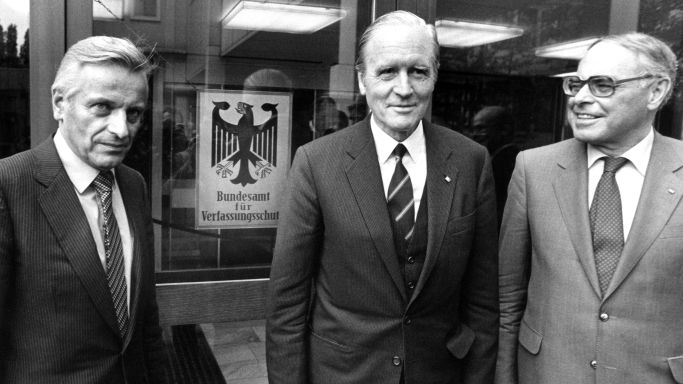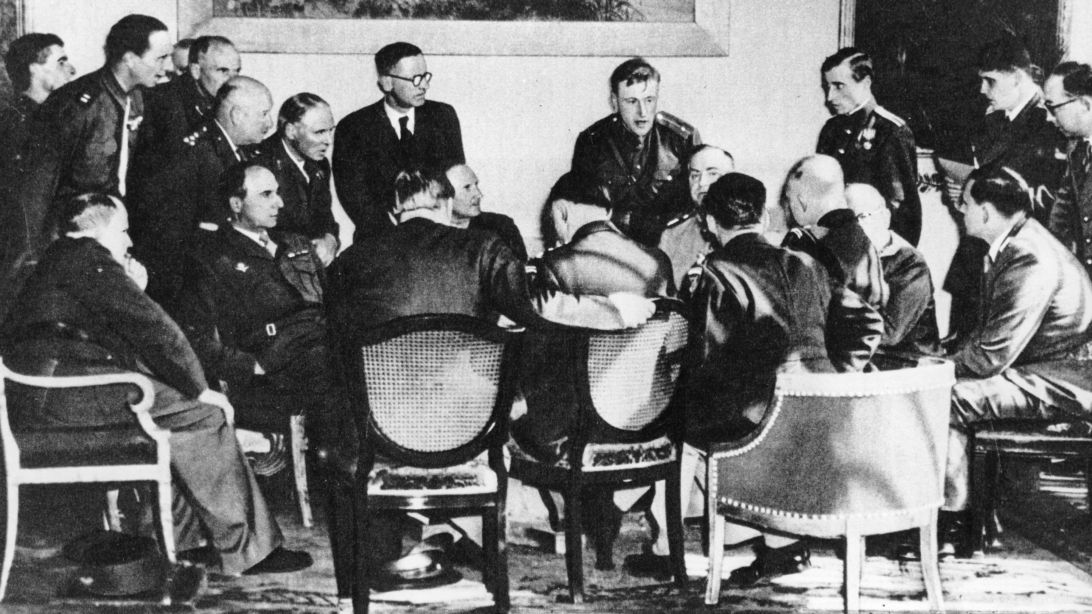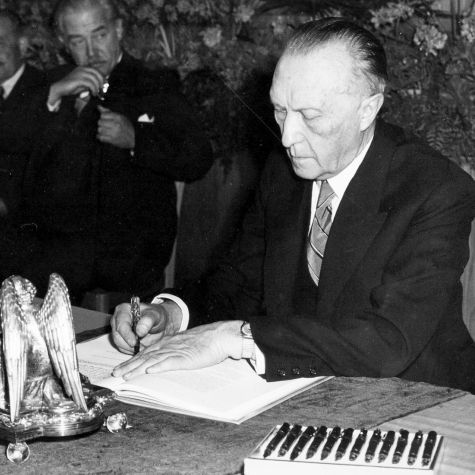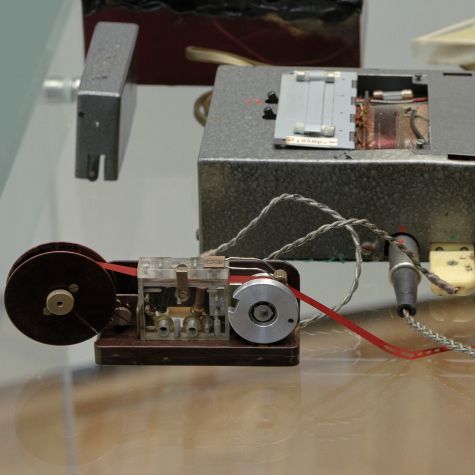Our history

On 8 May 1981 the then President of the Federal Republic of Germany Karl Carstens visited the Bundesamt für Verfassungsschutz (BfV) and was welcomed at the entrance of BfV’s former office building in Cologne by Dr Richard Meier, who was Director General of BfV back then. This was a novelty: For the first time ever, a head of state of the Federal Republic of Germany paid an official visit to the German domestic intelligence service, which had celebrated its 30th anniversary just the year before.
In retrospect, this visit may certainly also be interpreted as a sign of appreciation, bearing in mind that the security agencies of the Federation and the federal states had had to mobilise considerable resources in the years before that to meet the exceptional challenges they were faced with. In fact, Dr Richard Meier’s term of office (1975-1983) included the “German Autumn”, when the terrorism of the Red Army Faction (RAF) was at its height: the abduction and murder of Hanns Martin Schleyer, the president of the Confederation of German Employers’ Associations, the hijack of the Lufthansa aircraft “Landshut” and the suicides of the imprisoned members of RAF’s first generation in 1977.
Time and again, national and international events and developments like these have been crucial in shaping the work of the German domestic intelligence services and contributed to the setting of priorities. Thus, given the changing threats a free democratic society has to face, BfV’s history has at all times also been a reflection of the history of the Federal Republic of Germany as a whole.
In the following, some chapters of this history will be outlined:
End of World War II and reconstruction
The end of World War II on 8 May 1945 and Germany’s defeat as well as the Allied occupation formed the basis for Germany’s democratic reconstruction.
The lessons learned from the Weimar Republic and the Nazi dictatorship soon had an effect:

The Allied Control Council Law No. 31 of July 1946 forbade the German police to surveil or control political activities.
Moreover, the Parliamentary Council, whose task it was to draw up the Basic Law for the Federal Republic of Germany in 1948/49, understood, also in the light of the emerging conflict between the Western Allies and the Soviet Union, how real the threat of an expansion of totalitarian and despotic states (still) was. It was decided that the future constitution and laws should include provisions making the fight and defence against political extremism possible. The political system of the Federal Republic of Germany was to be a democracy determined and able to defend itself (“militant democracy”).
Founding years
The decision taken by the mothers and fathers of the Federal Republic of Germany to create a constitution based on specific values, which was to be effectively defended against its enemies, was followed by the setting up of BfV.
The founding stage especially was controlled in detail by the Western Allies. In the “police letter” of April 1949, the Allied military governors allowed the future Federal Government to establish a dedicated office “to collect and disseminate information about subversive activities directed against the Federal Government”.
At the same time, however, they prohibited the conferral of police powers on this authority. This illustrates the central idea, already implied above, underlying the creation of the German domestic intelligence services: a new Gestapo was to be prevented by all means. This was the birth of what is called the “principle of separation”, a principle of German law according to which the police and the intelligence services have to be separated in terms of their tasks, their organisation, their powers and their data processing.
The Basic Law of May 1949, consistent with the possibilities allowed for by the Allies, provided for a dedicated “central office for the compilation of data for purposes of protection of the constitution”.
In September 1950 the Act Regulating the Cooperation between the Federation and the Federal States in Matters Relating to the Protection of the Constitution (BVerfSchG) came into effect. This act obliged the Federation and the federal states to set up their own domestic intelligence services. The Federation complied with this obligation by establishing the Bundesamt für Verfassungsschutz (literally: Federal Office for the Protection of the Constitution; BfV) in November 1950; the federal states created their own services at different points in time after that. Initially, the 1950 BVerfSchG comprised only six sections, which were limited to organisational rules and tasks.
At working level, the most important thing was to protect the Federal Republic of Germany against attempted coups by left-wing or right-wing extremists. After all, the tragic end of the Weimar Republic and its devastating consequences until the end of World War II had been a collective traumatic experience and were a burden for the future that could not be ignored. Hence, it was also in the early years of the Federal Republic of Germany, in 1952 and 1956 respectively, that the Federal Constitutional Court imposed bans on the neo-Nazi Sozialistische Reichspartei (SRP, Socialist Reich Party) and on the Kommunistische Partei Deutschlands (KPD, Communist Party of Germany).
Cold War and division of Germany
The period of approximately 40 years between the founding of the German domestic intelligence services and German reunification was dominated by the East-West conflict (Cold War).
In this tense confrontation, the victorious powers of World War II formed two opposing camps: the Western camp under the leadership of the United States of America with the aim of containing Soviet communism, and the Eastern camp under the leadership of the Soviet Union in declared opposition to the “capitalism” and “imperialism” of Western states.
It was also during the period when Germany was divided that a wave of left-wing extremist terrorism hit the Federal Republic of Germany: a series of attacks, abductions and political murders committed by left-wing extremist groups shocked the country.
During these four decades, internal security first became internationalised, which would lead to an extension of the tasks entrusted to the German domestic intelligence services.
Counter-intelligence during the East-West conflict
The founding of the German Democratic Republic (GDR) as well as the establishment of the Ministry of State Security in February 1950 further contributed to the division into an Eastern and a Western bloc that had developed by then, thus noticeably aggravating the danger of growing communist influence on West Germany.
In the 1950s and 1960s the Federal Republic of Germany subsequently developed into a significant operational basis for Eastern and Western intelligence services alike, and the detection and prevention of espionage activities increasingly became the focus of the German domestic intelligence services’ efforts to protect the constitution.
The GDR in particular maintained an extensive network of spies on the territory of the Federal Republic of Germany. The GDR’s espionage was mainly aimed at collecting as much information as possible on a broad range of topics, but it was also a declared goal to infiltrate critical institutions of the Federal Republic of Germany like the Bundestag, federal ministries, the armed forces, the intelligence services, political parties and companies.
The recruitment of agents played a major role in this context. In 1965, for example, BfV assumed that communist intelligence services were trying to persuade between 1,000 and 3,000 people per year to carry out espionage activities directed against the Federal Republic of Germany, with the overwhelming majority being approached by the intelligence services of the GDR. Apart from promising economic incentives and large sums of money, the intelligence services of the GDR not infrequently tried to recruit people by blackmailing them.
Left-wing extremist terrorism
Approximately between 1967 and 1977, numerous left-wing, left-wing radical and left-wing extremist groups emerged around the APO movement (APO – extra-parliamentary opposition) and from within the student movement, organising mostly peaceful protests in connection with various topics like the Vietnam war, the “fustiness” of the Adenauer era or outdated social conventions.
Against the backdrop of this social climate, at the latest since the death of Benno Ohnesorg on 2 June 1967, groups formed whose actions culminated in left-wing extremist terrorism. One of the most significant left-wing terrorist organisations was the Red Army Faction (RAF), which propagated the “armed struggle” in the style of South American revolutionary concepts in order to “unmask” the allegedly fascist nature of the West German state.
Between 1972 and its dissolution in 1998, the RAF committed 26 attacks, some of them with devastating consequences, and killed a total of 34 people. RAF terrorism, which reached its height in the “German Autumn” in 1977, was the greatest challenge the domestic intelligence services and the entire security community in the young Federal Republic of Germany had had to face up to that point. It has had a lasting effect on the sense of security in the Federal Republic of Germany as well as on its legislation to this day.
Militant foreigners
The RAF committed its murders at a time when internal security first became internationalised. The security situation worsened considerably because of an increase in politically motivated acts of violence committed by groups of militant foreigners whose aims had their roots in the political and religious conflicts in their respective countries of origin.
On 10 February 1970, for example, Palestinian assailants attacked an Israeli aircraft at Munich-Riem Airport, killing one person and injuring twelve others. This attack was followed by several other antisemitic attacks in Munich. Another example is the attack that the Palestinian terrorist organisation Black September committed against the Israeli team at the Olympic Games in Munich on 5 September 1972. What started as a hostage-taking ended with the murder of eleven Israeli Olympic athletes and the death of a police officer.
In 1972, as a consequence of these events and developments, the BVerfSchG was amended so as to take this new international dimension into consideration. The area of responsibility of the German domestic intelligence services was expanded to include “extremism by foreigners”.
Present
The past two decades in the history of the German domestic intelligence services have primarily been shaped by the terrorist attacks of 11 September 2001. They were a watershed moment for German domestic and security policy as a whole and have resulted in fundamental changes to Germany’s security architecture.
Other events and developments that have had a profound effect on the domestic intelligence services of the Federation and the federal states have been, among others, the detection of the neo-Nazi terrorist group National Socialist Underground (NSU), the global surveillance and espionage affair in connection with the US National Security Agency (NSA) and the new requirements regarding the work of the German domestic intelligence services resulting from the comprehensive digital transformation of modern societies which is characterised by disruptive changes.
Consequences of the 9/11 attacks
On 11 September 2001, 19 suicide attackers of the Islamist terrorist network al-Qaeda hijacked a total of four passenger aircraft and used them as weapons against targets in the United States. Almost 3,000 people lost their lives when two of the planes hit the Twin Towers of the World Trade Center in New York City (New York) and one of them the Pentagon in Arlington (Virginia), and another one crashed in Shanksville (Pennsylvania). This terrorist mass murder aggravated the global security situation to an unexpected extent.
The fact that some of the attackers had spent extended periods of time in Germany increased the enormous pressure to act that the German security agencies found themselves confronted with from that moment on.

The Federal Government of the time subsequently passed several “anti-terrorist acts”, initially limited to a specific period of time, including the Act to Fight International Terrorism of 9 January 2002. This meant, among other things, that BfV’s tasks were extended to include monitoring of efforts directed against the concept of international understanding. Moreover, a stronger focus was put on preventive intelligence collection in order to guarantee effective threat prevention regarding terrorist efforts. BfV’s new competences included, for example, the possibility of requesting customer data from banks, airlines and postal service providers. Intelligence competences were also extended to include measures that make it easier to find out about the communication channels and travel routes used by private individuals. Legal provisions were adapted to facilitate the transfer of data and information between the services, which included the cooperation with foreign partners and law enforcement/prosecution agencies.
Finally, in 2004, the Joint Counter-Terrorism Centre (GTAZ) was established in Berlin in order to organise quick access to information and knowledge held by various agencies and to make resource-efficient analysis from different perspectives possible.
NSU and its consequences
When the existence of the right-wing neo-Nazi group National Socialist Underground (NSU) came to light on 4 November 2011, the dangers posed by right-wing extremist terrorism suddenly moved into the focus of public attention.
The NSU is responsible for what has been the series of right-wing extremist murders that has claimed the most lives in the history of the Federal Republic of Germany. Between 2000 and 2007 its members killed nine migrants and one police officer, committed attempted murder in 43 cases and carried out three bomb attacks as well as 15 robberies.
The gradual uncovering of the events marked a turning point in the handling of right-wing violence and the militant neo-Nazi scene.
The Act to Improve the Cooperation between the German Domestic Intelligence Services of 2015 has to be seen in the light of the parliamentary inquiry in connection with the NSU and its crimes motivated by racism. This act first of all provides for an improved cooperation of the domestic intelligence services of the Federation and the federal states as well as for a strengthening of BfV’s role as a central body within the German domestic intelligence community. Moreover, it includes provisions to enhance the information flow and the analytic capability, mainly by using the Intelligence Information System NADIS. Finally, a clearer and more transparent framework was established for the choosing and handling of confidential sources.
The uncovering of the NSU has had a lasting effect on the reorientation of the German domestic intelligence services to this day. It manifests itself, for example, in the increased efforts the domestic intelligence services of the Federation and the federal states are currently making when it comes to monitoring right-wing extremist tendencies and threats.
NSA and cyber attacks
In 2013 Edward Snowden published top secret documents of the US intelligence service NSA, thereby disclosing one of the largest global surveillance and espionage scandals in the history of espionage. At least since 2007 the United States and Great Britain had been monitoring both telecommunications and the Internet to a considerable extent and stored the data obtained. Moreover, there had reportedly been eavesdropping on institutions of the European Union and of the United Nations, and e-mail accounts of politicians, also of allied states, had reportedly been accessed. These actions, justified by the two countries as preventive measures to avoid terrorist attacks, partly lead to diplomatic tensions and raised a lively public debate about state surveillance measures. In 2014 a parliamentary committee of inquiry was established in order to investigate the extent and the background of the spying activities by foreign secret services in Germany.
The NSA scandal and its accompanying circumstances clearly had an impact on the German security architecture. It resulted, among other things, in increased resources so as to allow counter-intelligence work with a “360-degree view”, the examination of information received regarding technical surveillance (“signals intelligence”) and a strengthening of prevention.
The results of the German Bundestag’s committee of inquiry once more clearly showed how vulnerable national sovereignty is in an interconnected world. Over the following years, cyber attacks directed by intelligence services (“cyber intelligence”) – as for example the Russian cyber attack against the German Bundestag in 2015 – became a continuously growing challenge for the domestic intelligence services of the Federation and the federal states.
Current challenges
Over the last few years, digitisation has transformed society everywhere so that, today, there are hardly any “one-dimensional” threat situations of the kind that constituted a clear focus of the German domestic intelligence services’ work in previous decades. Nowadays, the domestic intelligence services of the Federation and the federal states have to face hybrid threats and a much more dynamic potential of action in all their fields of work, requiring their full attention and most of all increased adaptability, also in terms of technology.







